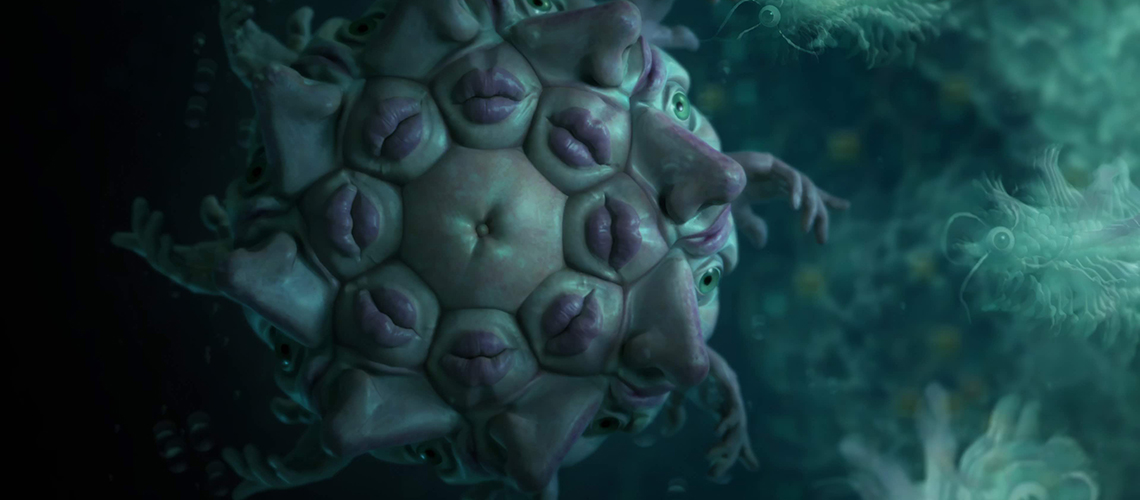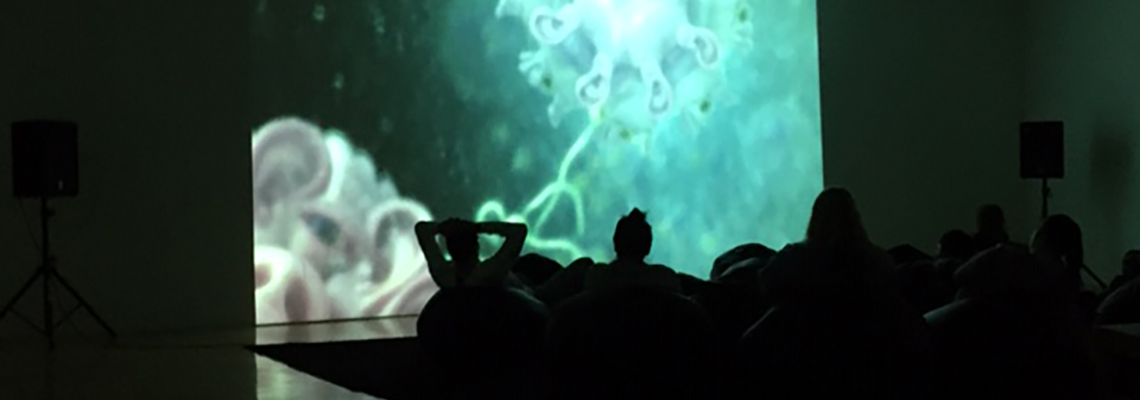
Lusus Naturae Revealed
by Carolyn Eyler, director of exhibitions and programs
The Icelandic creators of this twenty-two-minute animated video installation have dived deep and playfully stirred up a full-bodied, sensuous encounter with what could be considered the philosophical underpinnings of lusus naturae. Ólöf Nordal, her animator husband Gunnar Karlsson, and the composer Thuridur Jónsdóttir are steeped in the rich folklore of their Nordic island country, about which the travel writer Pico Iyer had remarked when visiting during the dark spell: “It’s easy to believe, in the uninhabited space, that you are living once more amidst the mead halls and monsters of Beowulf, within a tiny circle of light surrounded by an encroaching dark…”
Lusus naturae is a Latin concept evolving from ludere, to play, and was first used in the mid-1600s to define nature’s playful, whimsical, or less benign changes far from the norm. The resulting abnormalities and deformities cause freaks naturae –of nature. Ólöf became immersed in this idea when asked to participate in an exhibition on the cabinet of curiosities. These Renaissance prototypes of early museums composed of private cabinets or whole rooms in princely quarters were formed to house artifacts (curiosities) that were often brought back to Europe from the so-called New World. They were also used to display objects related to a growing body of scientific classification. Fascinating empirical examples of lusus naturae —and our deep ambivalence towards nature — have long been a wellspring for tall tales with mythological creatures. A few synonyms given for lusus naturae are giant, devil, freak, behemoth, dragon, mutant, titan, ogre, barbarian, hellion, and Frankenstein. Artistic depictions of freaks composed of a familiar human form with strange deviations embody unsettling change. While a single image instantly conveys a visual morphing, narrative formats can unfold developments over time through a character’s interactions with a lusus naturae. Usually persisting in a foolish delusion or negative trait, the character is suddenly confronted with the monster their actions may well have induced or revealed.
The plotless fantasy here offers an opportunity to contemplate lusus naturae face-to-face. The floor-to-ceiling video is a window onto a deep ocean world, and the screen’s black ocean edges merge with the darkness of the room. No salacious mermaids, just mildly disgusting computer-generated humanoid parts that ogle us, loll out long tongues, and exercise orifices in a soundscape that turns a familiar foundation of the human breath into an otherworldly environment. The creatures appear with little pops (breath pushed through flutes), low rumbles, and inscrutable ghost-on-the-water cries. Human parts circulate into view, compose into being, then float away like thought formations, or for that matter, all phenomenon that the Buddha taught has the nature of rising, abiding, and ceasing.
In the “new artic,” a region that includes Maine and Iceland, melting massive glaciers has spurred profound climatic, oceanic, geologic, economic, and political changes. Increased travel and cultural exchange between USM and Iceland’s academic institutions have in fact inspired Ólöf’s artist residency in the Art Department this spring. Certainly, the catastrophic changes to the Arctic Ocean and its creatures, and the implications for the rest of the world, are frightening and these environmental concerns are relevant to “Lusus Naturae.” But to impose that sole interpretation is to miss the expansive dimensions of change that shapes the profundity of this piece.

Lusus Naturae is sponsored by the CAHS Dean’s Cultural Affairs Fund and USM Student Life and co-organized with the USM School of Music. Special thanks to SeifAllah Salotto-Cristobal, USM Assistant Professor of Lighting Design; Lori Arsenault, former Performing Arts Operations and Concert Manager; and Alan Kaschub, Director, USM School of Music.
About the Artists:
Ólöf Nordal is one of Iceland’s most well-known artists. She uses various media to channel her work, primarily sculpture, photography, and video installation, in addition to public art. She has tackled various cultural, origin, and folklore topics, working with local and global matters. This year, a mid-career retrospective on Nordal’s work was mounted at the Reykjavik Art Museum, Iceland.
Gunnar Karlsson is a pioneer in Icelandic animation and works both as director and creative director on his films, which have received numerous awards at international film festivals. His latest full-length animated feature was Ploe – You Never Fly Alone (2018). Gunnar Karlsson is also an avid illustrator, political cartoonist, and painter.
Thuridur Jónsdóttir has written various types of compositions, some include electronic sounds, audience participation, dramatics, and sounds from nature. Her works have been performed by Icelandic and international orchestras at renowned music festivals. This winter, new work by Jónsdóttir will be premiered in Disney Hall, LA, commissioned by the Los Angeles Philharmonic Orchestra.
Gunnar Karlsson, Thuridur Jónsdóttir, and Ólöf Nordal have collaborated before, on Nordal’s video work Sealmaiden (2006–2009), the audiovisual happening Cock’s Egg (2005), and the multimedia project The Billy and the Lady of the Manor (2009).
Ólöf Nordal’s artist residency is sponsored by the Warren Memorial Foundation Visiting Artist Series and the Maine Economic Improvement Fund (MEIF) with additional community support from the Maine International Trade Center. For more information on Ólöf’s artist residency project, Hella Rock, please click here.

